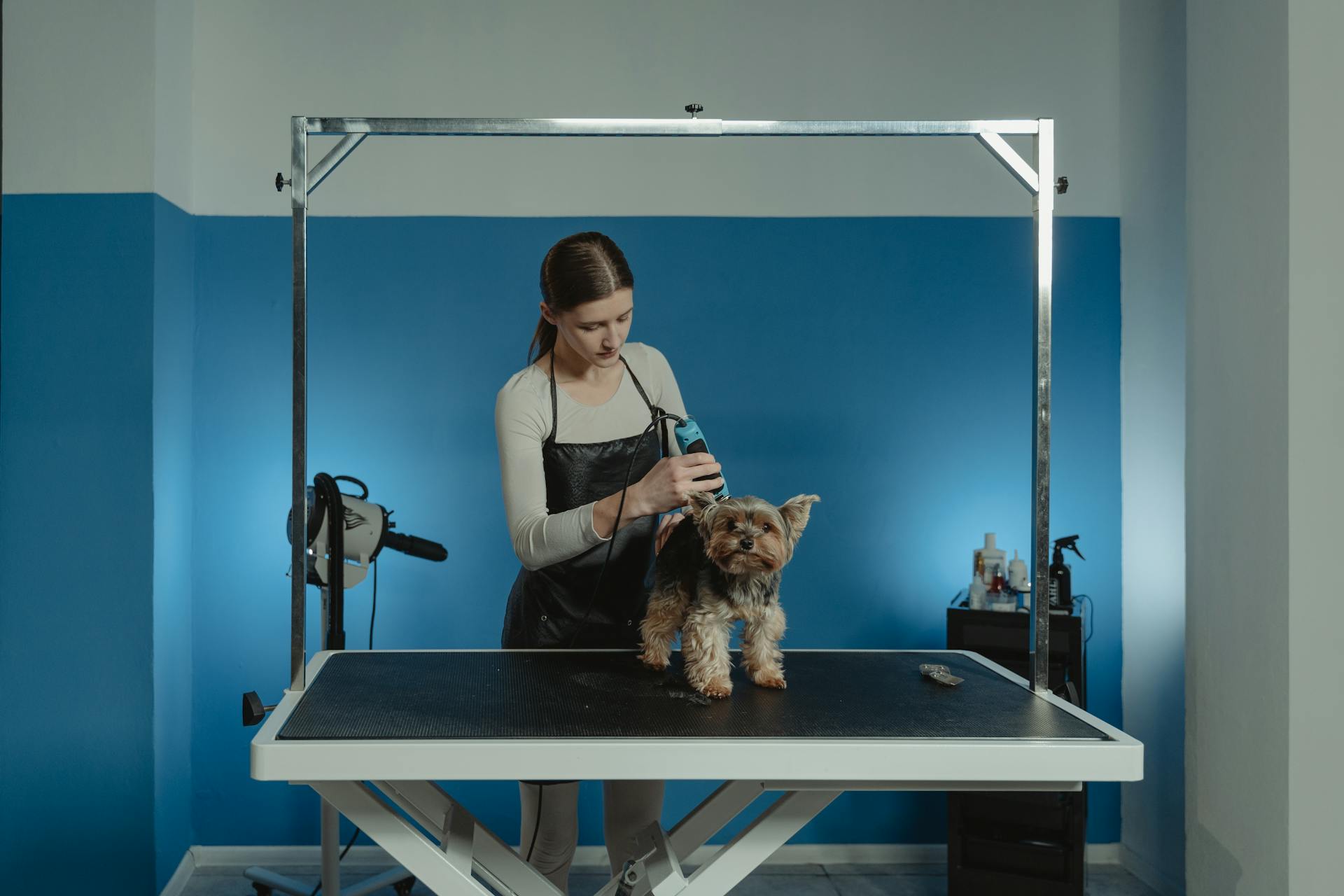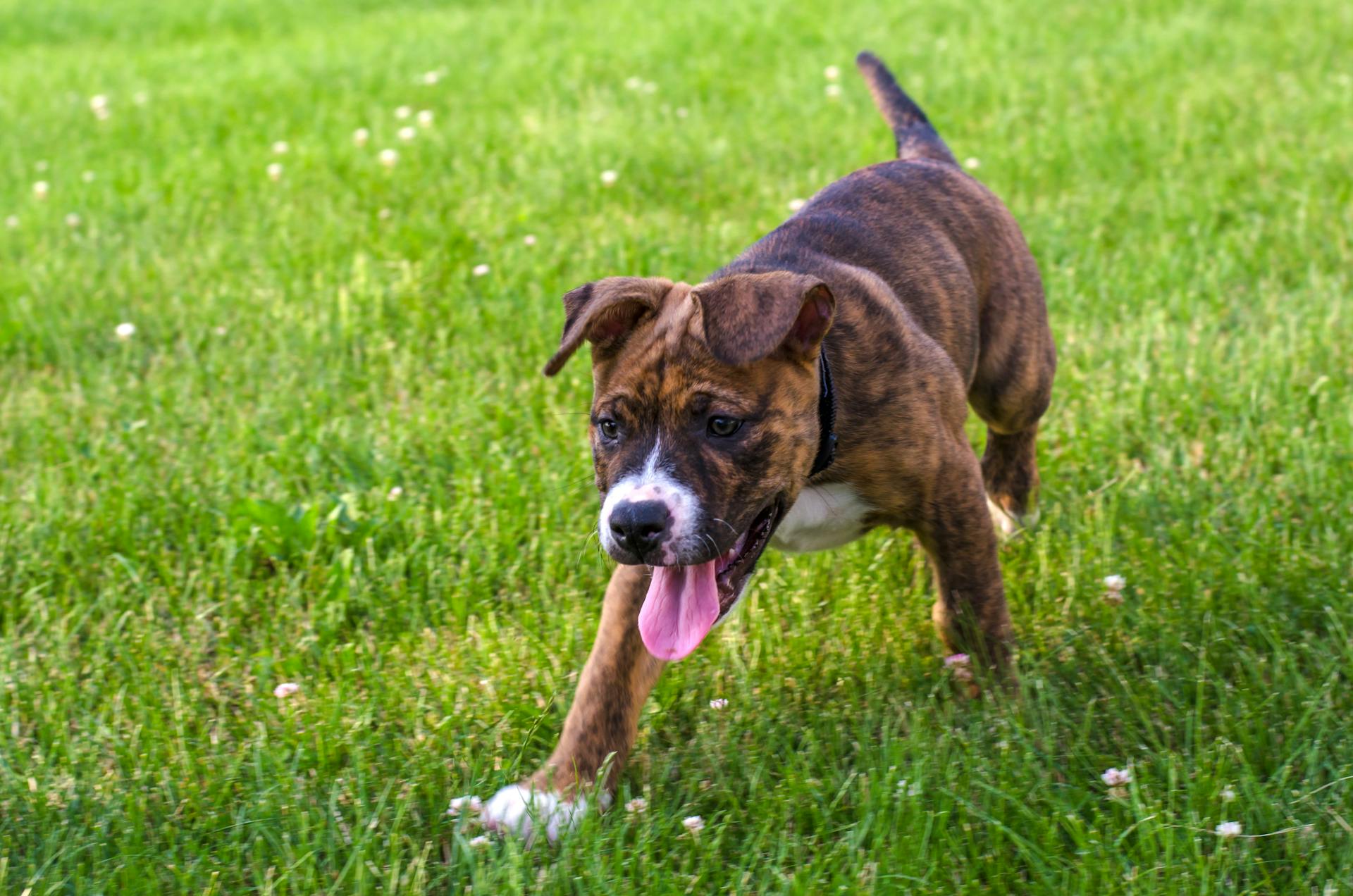
The Blue Rat Terrier is a small, energetic breed that makes a great companion for active families.
They typically weigh between 10-25 pounds and stand about 10-15 inches tall at the shoulder. Their small size requires less space, making them perfect for city living or apartments.
Their short, smooth coat requires minimal grooming, but they do need regular nail trimming and ear cleaning to stay healthy.
These dogs are known for their intelligence and affectionate nature, making them easy to train with positive reinforcement.
On a similar theme: 10 Fun Facts about Chihuahuas
History and Origin
The Rat Terrier breed has a rich history that dates back to the early 20th century. They were originally bred on American farms to catch rats and other pests.
Their ancestors include the Fox Terrier, Bull Terrier, Manchester Terrier, and Old English White Terrier, among others. Farmers used these breeds to create a dog that was quick, agile, and good at hunting.
The Rat Terrier's speed came from the Whippet, while their strong sense of smell was inherited from the Beagle. They were bred to be versatile and effective at catching a variety of prey.
Intriguing read: English Cocker Spaniel Field
In the 1920s, Toy Fox Terriers were introduced to the Rat Terrier's breeding program, leading to the development of a toy-sized version of the breed. This is how the Teddy Roosevelt Terrier, also known as the short-legged Rat Terrier, came to be.
The Rat Terrier was a common sight on American farms between the 1910s and 1940s, but their numbers declined when poison became the primary method for rodent control. However, a few dedicated breeders kept the breed alive until it experienced a resurgence in the late 1970s.
Today, Rat Terriers are recognized by the American Kennel Club and make excellent pets for families and hunters alike. They're known for their intelligence, energy, and affectionate nature.
Physical Characteristics
Rat Terriers come in numerous colors, and one thing they all have in common is the presence of white on their body.
Each Rat Terrier is unique, with 18 colors recognized by the AKC, ranging from blue to lemon to red.
Every Rat Terrier must include white somewhere on their body, making them instantly recognizable.
Their size can vary, but they're all relatively small, with two size divisions recognized: Miniature (10–13 inches) and Standard (13–18 inches).
Coat Color and Grooming

Rat Terriers have a short, smooth coat with dense, shiny fur that comes in a variety of colors, including white, black, tan, red, lemon, blue, chocolate, and orange. They all have white markings.
Their coat requires minimal maintenance, with only weekly brushings needed to keep it shiny and healthy. A curry brush or rubber mitt is perfect for the job. You can also use a deodorizing spritz to freshen them up in between baths.
Rat Terriers shed heavily in the spring and fall, as well as after whelping or heat cycles. Brushing regularly can help prevent tiny hairs from invading your home. Bathe them monthly, unless they've had extra fun outside, and trim their nails about once a month to prevent painful tears.
Their dental care is crucial, with an annual professional tooth cleaning and daily toothbrushing required to prevent gum disease and bad breath. Brush their teeth at least two or three times a week, and daily brushing is even better. Trim their nails once or twice a month, and check for sores, rashes, or signs of infection on the skin, in the nose, mouth, and eyes, and on the feet.
For your interest: Shiny Legendary Dogs
Here are some essential grooming tips for your Rat Terrier:
- Brushing: Weekly brushing with a curry brush or rubber mitt
- Bathing: Monthly baths, with deodorizing spritzes in between
- Dental care: Daily toothbrushing, with annual professional tooth cleaning
- Nail trimming: Trim nails once or twice a month
- Ear cleaning: Check ears weekly for debris and signs of infection
By following these grooming tips, you'll be able to keep your Rat Terrier's coat healthy, shiny, and looking its best.
Available in Two Sizes
Rat Terriers come in two sizes: Miniature and Standard.
The Miniature size ranges from 10 to 13 inches in height.
Health and Care
Blue Rat Terriers can live a long and healthy life, typically ranging from 12 to 18 years.
To ensure your Blue Rat Terrier stays healthy, it's essential to be aware of potential health issues. Rat Terriers are prone to hip dysplasia, which can cause pain and cartilage loss if not addressed.
Daily exercise and a balanced diet can help prevent hip dysplasia and other health problems. However, even with proper care, Rat Terriers can still develop health issues like Patellar Luxation, which causes the kneecap to dislocate.
To identify potential health problems early on, it's crucial to monitor your Blue Rat Terrier's behavior and physical condition. If you notice any signs of pain or discomfort, consult your veterinarian immediately.
See what others are reading: Patterdale Terrier Health Problems
Here are some common health issues that can affect Blue Rat Terriers:
- Hip Dysplasia: causes pain, cartilage loss, and scar tissue
- Patellar Luxation: causes the kneecap to dislocate, resulting in pain and loss of function
- Legg-Calve-Perthes Disease: causes the hip joint to deteriorate, leading to pain and surgery
- Heart Disease: can cause heart problems, especially in senior years
- Eye Disease: can lead to blindness due to primary lens luxation
Health
Rat Terriers are generally a healthy breed, but like all dogs, they can be prone to certain health issues. They have a decent life expectancy, living up to 12-18 years.
Hip dysplasia is a common concern, which can cause pain and cartilage loss if left untreated. It's often-genetic and can be addressed with weight management, physical therapy, or surgery.
Patellar luxation is another issue that can affect Rat Terriers, causing the kneecap to dislocate and resulting in pain and loss of function. Treatment options include joint supplements, pain medication, and in severe cases, surgery.
Legg-Calve-Perthes disease can be very painful for Rat Terriers, as it causes the hip joint to deteriorate. Surgery is often the treatment of choice.
Heart disease can become a concern as Rat Terriers age, so it's essential to monitor their heart health closely. Your veterinarian may refer you to a veterinary cardiologist for an echocardiogram if they detect a heart murmur.
Eye disease is another potential issue, with primary lens luxation being a common concern. This can lead to teary, red, and/or cloudy-looking eyes, and eventually, blindness.
Here are some common health issues that can affect Rat Terriers:
- Hip dysplasia
- Patellar luxation
- Legg-Calve-Perthes disease
- Heart disease
- Eye disease (primary lens luxation)
Care

Crate training is a great idea for Rat Terriers, but don't forget to give them a break and let them out regularly. They shouldn't spend more than a few hours at a time in a crate, except when they're sleeping at night.
Daily exercise and consistent training are crucial for Rat Terriers. They need a pet parent who is as determined and dedicated as they are. They're affectionate and love family life, and they're adaptable enough to be anything from apartment-dwellers to farm hands.
Rat Terriers have short coats that are easy to groom. They only need to be brushed a few times a week, but they shed just as much as the average dog. To keep them healthy, they'll need a bath every 4 to 6 weeks, nail trims, ear cleanings, and teeth brushing.
Here's a quick rundown of Rat Terrier grooming needs:
- Brushing: Weekly brushing with a soft brush or rubber curry mitt
- Bathing: Every 4 to 6 weeks, or as needed
- Nail trimming: Trim nails once or twice a month
- Ear cleaning: Check ears once a week for excess wax and debris
- Dental care: Brush teeth at least two or three times a week, ideally daily
Regular grooming not only keeps your Rat Terrier clean and healthy, but it also helps them get used to being handled and examined. This makes it easier for vet visits and other procedures.
Feeding

Feeding your Rat Terrier is an essential part of their overall health and care. To determine the right amount of food for your dog, consider their size, age, build, metabolism, and activity level.
A highly active dog will need more food than a couch potato dog. The quality of dog food also makes a difference - better food will go further and nourish your dog better.
You should feed your Rat Terrier twice a day, rather than leaving food out all the time. This will help keep them in good shape.
To check if your Rat Terrier is overweight, give them the eye test and the hands-on test. You should be able to see a waist when looking down at them, and feel their ribs without having to press hard.
Here's a guide to help you determine the right amount of food for your Rat Terrier:
Don't forget to check your Rat Terrier's ears weekly for redness or a bad odor, which can indicate an infection.
Temperament and Training
Rat Terriers are a big personality in a compact body, with an inquisitive and highly intelligent nature that makes them a joy to be around. They're natural problem-solvers and love puzzles and games.
Their intelligence and trainability make them easy to train, especially with rewards-based training that focuses on praise and positive reinforcement. They're determined and will do whatever it takes to get to the most rewarding outcomes.
Rat Terriers are good with kids and other dogs, but they can be wary of strangers and may not warm up to them immediately. Early socialization is key to ensure they grow up to be well-rounded dogs.
To minimize barking, introduce training to help reduce barking at the doorbell, and provide plenty of exercise to keep their sharp minds occupied. A tired dog is a happy dog, after all.
Here are some key traits to expect from a Rat Terrier:
- Intelligent and trainable
- Good with kids and other dogs
- Wary of strangers, but can warm up with socialization
- Naturally inclined to alert owners to potential threats
- Prey-driven and may chase small animals
With the right training and socialization, Rat Terriers can make wonderful family pets and loyal companions.
Do They Bark?
Rat Terriers are known to be big barkers, so if you're an apartment dweller or sensitive to sound, this breed might not be the best fit.
Their natural instinct to alert and protect their family means they'll likely bark when someone comes to the door.
You can try training your Rat Terrier to listen to commands like "hush", but it'll take patience and time to overcome their inherent terrier instincts.
Rat Terriers can get along with kids and other dogs, but proper socialization from a young age is crucial to ensure they're friendly and well-adjusted.
If you keep pets like rats, mice, hamsters, or birds, you'll need to take precautions to keep them separated, as Rat Terriers have a strong instinct to chase vermin.
Early and deliberate introductions can help Rat Terriers get along with cats, but it's essential to supervise their interactions.
Their strong instinct to chase small animals can lead to sudden lunges, even with training, so be prepared for unexpected moments on walks.
Take a look at this: How Strong Is a Tibetan Mastiff
Temperament & Intelligence
The Rat Terrier is an incredibly sharp and alert dog, incredibly keen on their surroundings and able to detect even the slightest movement. Their prey drive is incredibly high, making them talented hunters.
Rat Terriers are wary of strangers and may not warm up to them immediately, but most will eventually warm up to visitors. If they are not properly socialized, they may become aggressive to strangers and other animals.
These small-sized dogs are usually very friendly and tend to get along with kids and other dogs, but it's essential to remember that all dogs are individuals, so this can differ from Rattie to Rattie.
Rat Terriers are good watchdogs, so don't be surprised if they bark when someone comes to the door. If you feel that it's excessive, there are options to help you reduce your dog's barking.
Their intelligence and trainability make them quick learners and adaptable to various training tasks and dog sports. They are highly intelligent and eager to please, which makes them excellent companions for active individuals or families.
Rat Terriers are incredibly determined and can figure out how to do just about anything, so if there's somewhere you don't want them to get to, or there's something you don't want them to have, they can be pretty resourceful when they want to be.
Here's a breakdown of the Rat Terrier's temperament traits:
Their people live by the mantra that a tired dog is a good dog, so they need a lot of exercise to keep them happy and healthy.
9/11 Search and Rescue Effort
Around 300 search and rescue dogs joined the recovery effort at Ground Zero following the 9/11 terrorist attacks.
Their small size and determination made them instrumental in the recovery effort, allowing them to go into tighter, precarious areas.
Ricky, a Rat Terrier, was one of the most notable 9/11 dogs, helping workers cover more ground and recover several bodies.
His small size was particularly helpful, enabling him to navigate areas that larger dogs couldn't.
See what others are reading: Dogs Breeds That Start with B
Exercise

Exercise is a crucial part of a Rat Terrier's life. They have a lot of energy and need at least 30 minutes of daily exercise to stay happy and healthy.
Rat Terriers are natural athletes and love to play fetch, find snacks, and track scents. They don't tire easily, but they do need regular breaks to rest and recover.
If you're an active person, your Rat Terrier will love to join you on your adventures. They're great companions for runs, hikes, and even water activities like swimming. In fact, they enjoy splashing in water so much that a day trip to the coast or a lake is a great idea.
If you don't have a backyard, don't worry – indoor games of fetch or hide-and-seek are a great way to satisfy their need for play. You can also try tug-of-war with a rope toy while you watch TV.
To keep your Rat Terrier safe, make sure your backyard is fenced in with a very tall fence – they can jump as high as 4 to 5 feet. With regular exercise and mental stimulation, your Rat Terrier will thrive and be a happy, healthy companion.
Recommended read: Puppys That Don't Grow
Frequently Asked Questions
What is the tri color Rat Terrier?
The Tri Color Rat Terrier is a color variation that features a combination of black, chocolate, blue, or pearl and white with copper points. This color pattern is the result of a recessive gene, making it distinct from other Rat Terrier coat colors.
Featured Images: pexels.com


